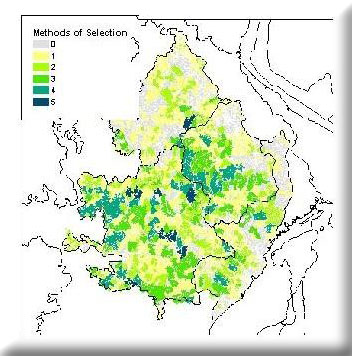
Objectives
- Complete and organize aquatic gap analysis data for practical use.
- Improve the Missouri Landcover Database.
- Analyze and organize Gap Analysis, Breeding Bird Atlas, NWI, and other data layers to facilitate conservation planning.
- Define landscapes of significance to different animal functional groups or ‘guilds’.
“Aquatic” Information Products and Activities:
1. Complete Aquatic ECS to the valley segment level and prepare for delivery (e.g. complete metadata, etc.)
2. Complete species distribution models and prepare for delivery
3. Complete a ‘segmentshed’ data layer and associated statistics (percent landcover, geology, road density, soils, etc.) for the state. Having watershed-specific information for every single stream will: facilitate better assessment of existing, potential, and possible future conditions for any or every stream reach within the state; significantly improve predictive distribution models for aquatic biota; enhance research efforts seeking to identify relations between natural and anthropogenic watershed conditions and the physical, chemical, hydrologic, and biological conditions within streams; and enhance chemical and biological monitoring efforts .
“Terrestrial” Information Products and Activities:
1. Improve the landcover data layer; modify, analyze, and deliver existing data in an easily accessible format
2. Access, analyze, and manipulate Gap Analysis vertebrate species distribution model data to make them spatially accessible and useful and provide analyses of Breeding Bird Atlas data
3. Complete a new and improved landcover data layer for at least 75% of Missouri by October 31, 2004
4. Calculate landcover statistics (e.g. %forest, grassland, cropland, etc.) within a ‘sliding window’ to facilitate evaluation of landscapes in a larger context and evaluation of habitat for species ‘guilds’ or ‘functional groups’
1. Complete Aquatic ECS to the valley segment level and prepare for delivery (e.g. complete metadata, etc.)
2. Complete species distribution models and prepare for delivery
3. Complete a ‘segmentshed’ data layer and associated statistics (percent landcover, geology, road density, soils, etc.) for the state. Having watershed-specific information for every single stream will: facilitate better assessment of existing, potential, and possible future conditions for any or every stream reach within the state; significantly improve predictive distribution models for aquatic biota; enhance research efforts seeking to identify relations between natural and anthropogenic watershed conditions and the physical, chemical, hydrologic, and biological conditions within streams; and enhance chemical and biological monitoring efforts .
“Terrestrial” Information Products and Activities:
1. Improve the landcover data layer; modify, analyze, and deliver existing data in an easily accessible format
2. Access, analyze, and manipulate Gap Analysis vertebrate species distribution model data to make them spatially accessible and useful and provide analyses of Breeding Bird Atlas data
3. Complete a new and improved landcover data layer for at least 75% of Missouri by October 31, 2004
4. Calculate landcover statistics (e.g. %forest, grassland, cropland, etc.) within a ‘sliding window’ to facilitate evaluation of landscapes in a larger context and evaluation of habitat for species ‘guilds’ or ‘functional groups’
We provided data on terrestrial and aquatic natural resources in aid of the development of Missouri Department of Conservation’s Comprehensive Wildlife Conservation Plan. This process identified conservation opportunity areas for the state of Missouri. Copies if the this report may be obtained from the Missouri Department of Conservation.
